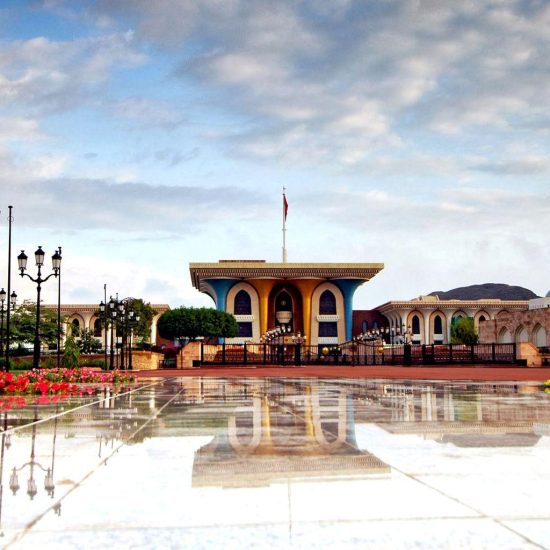Oman – An Enchanting Tour with Dolphin Watching & Dune Bashing!
₹45000 per person
Oman, officially the Sultanate of Oman, is a country located in West Asia. It is situated on the south-eastern coast of the Arabian Peninsula and spans the mouth of the Persian Gulf. It shares land borders with Saudi Arabia, United Arab Emirates, and Yemen, while sharing maritime borders with Iran and Pakistan. The capital city is Muscat. Oman has a population of 5,492,196 and is ranked the 120th most populous country in the world. The coast is formed by the Arabian Sea on the southeast, and the Gulf of Oman on the northeast. The Madha and Musandam exclaves are surrounded by United Arab Emirates on their land borders, with the Strait of Hormuz (which it shares with Iran) and the Gulf of Oman forming Musandam’s coastal boundaries.
Oman lies between latitudes 16° and 28° N, and longitudes 52° and 60° E. A gravel deserts plain covers most of central Oman, with mountain ranges along the north (Al-Hajar) and southeast coast (Qara or Dhofar Mountains), where the country’s main cities are located: the capital city Muscat, Sohar and Sur in the north, and Salalah in the south and Musandam. Oman’s climate is hot and dry in the interior and humid along the coast.
The peninsula of Musandam (Musandem), strategically located on the Strait of Hormuz, is an exclave separated from the rest of Oman by United Arab Emirates. The series of towns known collectively as Dibba are the gateway to the Musandam peninsula on land and the fishing villages of Musandam by sea.
Madha, another exclave, is an enclave within UAE territory located halfway between the Musandam Peninsula and the main body of Oman.[120] Madha, part of the Musandam governorate, covers approximately 75 km2 (29 square miles). Madha’s boundary was settled in 1969, with the north-east corner of Madha barely 10 m (32.8 feet) from the Fujairah road. Within the Madha exclave is a UAE enclave called Nahwa, belonging to the Emirate of Sharjah, situated about 8 km (5 miles) west of the town of New Madha, and consisting of about forty houses with a clinic and telephone exchange.
The central desert of Oman is a source of meteorites for scientific analysis.
Oman has one of the most diverse environments in the Middle East with various tourist attractions and is particularly well known for adventure and cultural tourism. Muscat, the capital of Oman, was named the second-best city to visit in the world in 2012 by the travel guide publisher Lonely Planet. Muscat also was chosen as the Capital of Arab Tourism of 2012.
Outwardly, Oman shares many of the cultural characteristics of its Arab neighbours, particularly those in the Gulf Cooperation Council. Despite these similarities, important factors make Oman unique in the Middle East. These result as much from geography and history as from culture and economics. The relatively recent and artificial nature of the state in Oman makes it difficult to describe a national culture; however, sufficient cultural heterogeneity exists within its national boundaries to make Oman distinct from other Arab States of the Persian Gulf. Oman’s cultural diversity is greater than that of its Arab neighbours, given its historical expansion to the Swahili Coast and the Indian Ocean.
Oman has a long tradition of shipbuilding, as maritime travel played a major role in the Omanis’ ability to stay in contact with the civilisations of the ancient world. Sur was one of the most famous shipbuilding cities of the Indian Ocean. The Al Ghanja ship takes one whole year to build. Other types of Omani ship include As Sunbouq and Al Badan.
By 2020, Oman’s population exceeded 4.5 million. About half of the population lives in Muscat and the Batinah coastal plain northwest of the capital. Omanis are predominantly of Arab, Baluchi and African origins. Around 20% of Omanis are of Baloch descent whose ancestors migrated to Oman centuries ago, and are now considered native.
Omani society is largely tribal and encompasses three major identities that of the tribe, the Ibadi faith and maritime trade. The first two identities are closely tied to tradition and are especially prevalent in the interior of the country, owing to lengthy periods of isolation. The third identity pertains mostly to Muscat and the coastal areas of Oman, and is reflected by business, trade, and the diverse origins of many Omanis, who trace their roots to Baloch, Al-Lawatia, Persia and historical Omani Zanzibar.
-
Tour Duration
5 Nights / 6 Days -
Best Season
October to April -
Cities Covered
Muscat -
Tour Category
TVS Classic
DAY 01 - OMAN ARRIVAL
DAY 02 - HALF DAY MUSCAT CITY TOUR
DAY 03 - NIZWA EXCURSION
DAY 04 - ENJOY WAHIBA SANDS (DESERT) OR VISIT WADI BANI KHALID (RIVER/LAKE)
DAY 05 - DOLPHIN WATCHING
DAY 06 - BID ADIEU TO OMAN
Tour Location
Leave a Reply
- 05 nights’ accommodation at the chosen hotel
- Daily Breakfast
- Muscat half day city tour
- Onward & Return airport transfers
- Day excursion of Wahiba Sands including Dune Bashing.
- Day excursion to Nizwa city with visits to ancient forts.
- Dolphin Watching tour.
- All taxes including VAT.
- Air fares
- Visa Fee
- Entrance fees
- 5% GST
- 5% or 20% TCS as per government norms
- Travel & Medical Insurance
- Other Meals (Lunch, Dinner, Snacks)
- Anything not mentioned under inclusions








